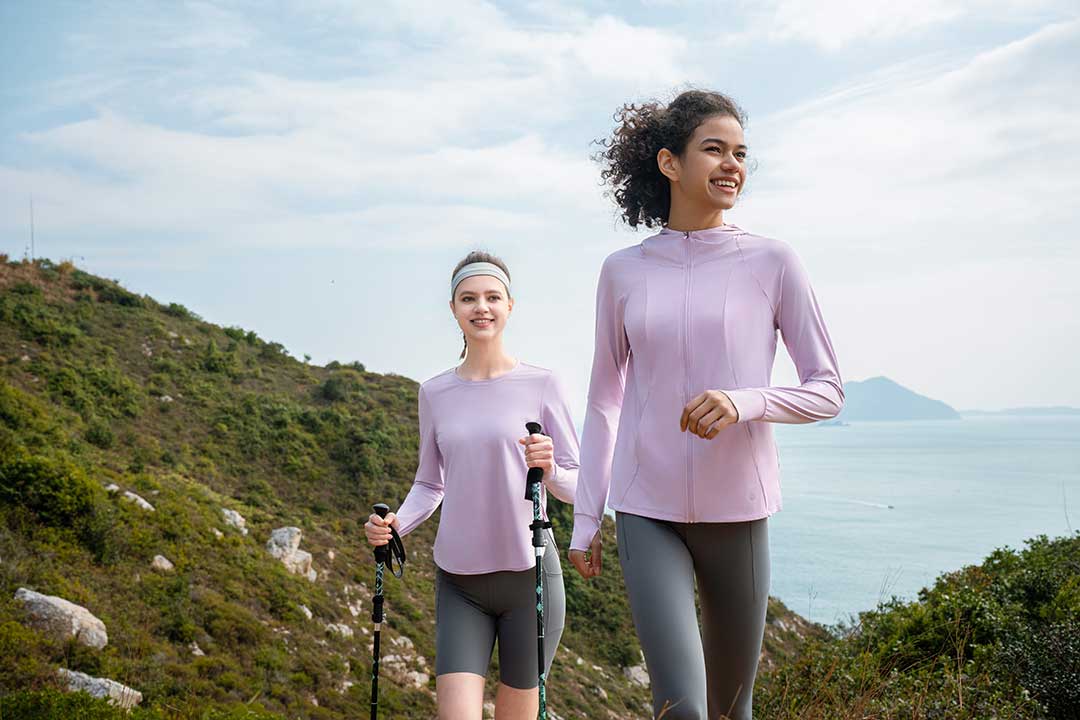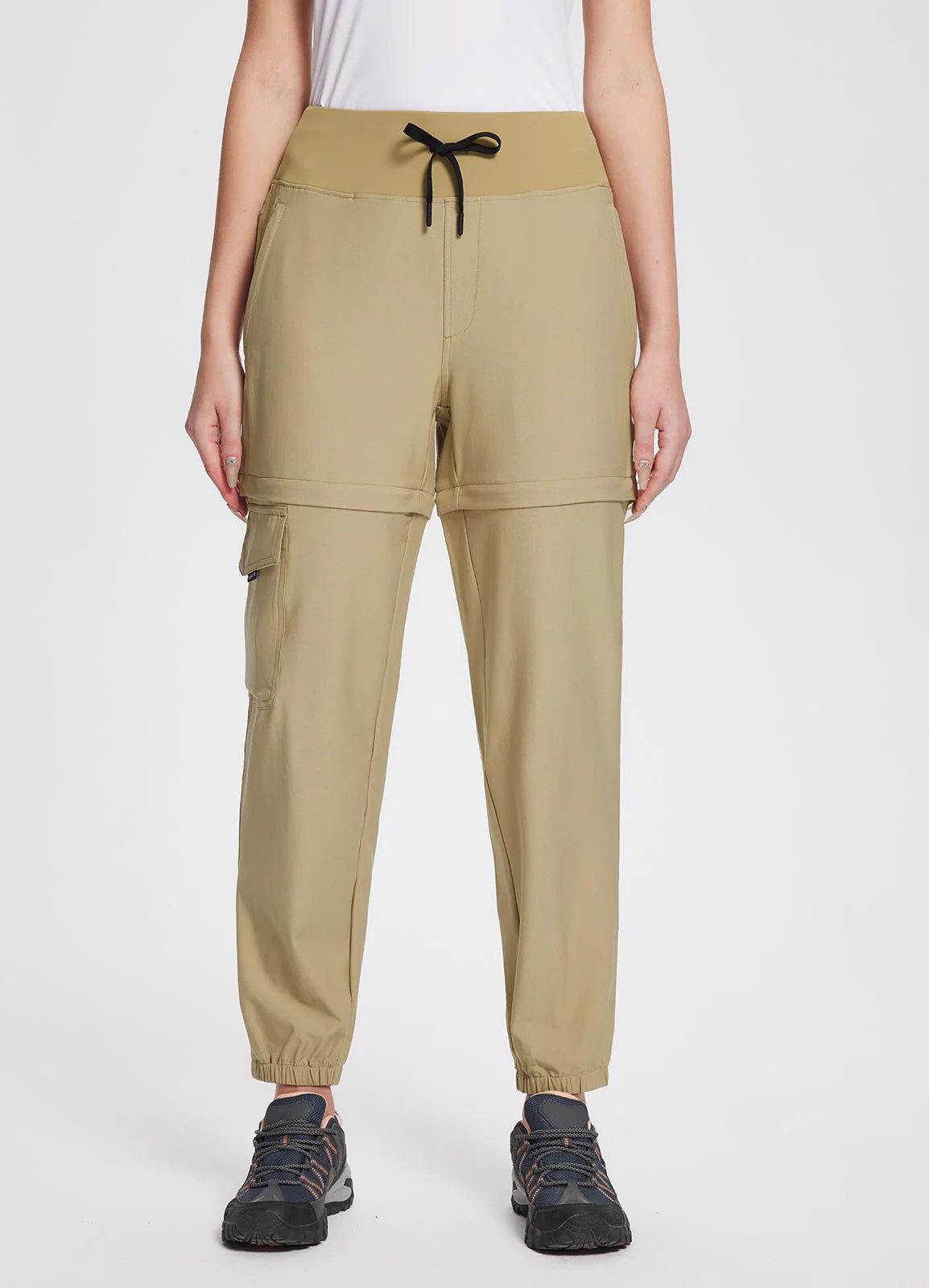Attention all outdoor lovers, newbies, and seasoned pros alike! Imagine a serene campsite beneath the twinkling stars, embraced by nature's melody. But before you embark on your wilderness journey, let's talk essentials about women's clothes for camping.
Bundle up too much, and you'll feel like you're in a sauna. Too few layers, and you risk shivering all night. But fear not! With our handy guide on what clothes to wear for camping, you'll be prepared for any adventure. From choosing the perfect outfit to mastering layering techniques, we've got you covered. So gear up and get ready for unforgettable memories beneath the open sky!
What To Wear for Camping

Whether you're trekking solo or adventuring with friends, your choice of camping clothes for women can make or break the outdoor experience.
Gear up for the weather and season.
Researching the forecast ahead of time will guide your clothing choices. Take into account the season to determine if you need to layer up for warmth or go for breathable fabrics to stay cool in the heat.
Dress to match your outdoor activities.
From conquering mountain peaks to swimming in tranquil lakes or casting lines in your favorite fishing spot, the possibilities are endless. But to ensure a successful adventure, tailor your attire to your planned activities. Create an itinerary and prepare special outfits for each activity on your list.
Remember that you might get dirty.
When camping or hiking, expect the unexpected – plans can change, and getting dirty is all part of the adventure. Always pack spare clothes to handle any muddy mishaps that come your way.
Be fabric savvy.
Your choice of fabric for each layer plays a significant role in your warmth and comfort during your journey. Explore the most common types of fabrics below, along with their advantages and disadvantages.
Cotton
Cotton is perfect for lounging around the campsite or during relaxed car-camping trips. However, it's not the best choice for physical activities like hiking to your campsite. While cotton is breathable, it lacks insulation and moisture-wicking properties.
Avoid using cotton as a base layer, particularly in cold or wet conditions as it absorbs moisture and dries slowly.
Synthetics
Nylon and polyester stand out as the go-to synthetic fabrics for several reasons. Renowned for their durability and quick-drying properties, they outshine natural materials in many outdoor scenarios. These synthetic fabrics excel as outer layers, comprising garments like pants, shirts, and jackets.
Surprisingly, fleece jackets, though they evoke images of sheep's wool, are crafted from synthetic polyester. They serve as excellent choices for chilly weather outerwear.
Yet, it's worth noting that synthetic clothing is prone to retaining odors and may not offer the same level of warmth as other fabric options.
Merino Wool
While wool was once infamous for its scratchiness, recent advancements have transformed its reputation.
Merino wool, in particular, stands out as an itch-free, breathable, moisture-wicking fabric that excels at remaining odor-free. These qualities make it ideal for socks and base layers. However, its premium performance comes at a higher price compared to other materials and may still pose some discomfort for those with sensitive skin.
Layer well.
Even if the trails are chilly, expect to work up a sweat. Proper layering allows you to adjust your clothing as needed—shedding layers when you warm up and adding them back on if the cold sets in.
By mastering the art of layering, you can select garments and materials that ensure your comfort throughout your adventure.
Remember: the base layer keeps you dry, the mid-layer provides warmth, and the outer layer shields you from the elements.
Choose the right fabrics as base layers.
When it comes to underwear, sports bras, and tank tops, prioritize synthetic fabrics like nylon and polyester. These materials effectively wick moisture away from your body, preventing chafing and rashes.
Avoid natural fibers, like cotton, as they retain moisture and take longer to dry, leaving you feeling cold and damp.
When packing for your camping trip, bring one pair of underwear for each day planned. For longer backpacking trips where weight is a concern, two pairs should suffice, and you can rinse them as needed. Go for looser-fitting underwear to enhance breathability.
In colder conditions, consider wearing long underwear as your base layer to retain warmth close to your body.
For warmer weather, moisture-wicking tank tops provide a refreshing base layer, helping you stay cool and fresh even in the heat.
Go for t-shirts, sweatpants, and short pants.
A well-made tee crafted from quality synthetic materials proves versatile across all seasons: it serves as an excellent base layer in colder climates and a standalone shirt in warmer regions. Plan to bring one to two t-shirts for your trip, and you can wash them as needed.
Though not typically associated with camping or hiking, joggers and sweatpants offer cozy warmth for chilly nights. Specifically, joggers provide a lightweight and breathable option for warmer months.
In the unpredictable outdoors, temperature shifts can catch you off guard. Simplify your wardrobe with convertible pants, like our Laureate High Rise UPF50+ Hiking Pants, which are crafted from breathable synthetic materials. They seamlessly transition between pants and shorts as needed throughout the day.
For optimal carrying capacity, consider investing in a sturdy pair of cargo hiking pants. Equipped with extra pockets for tools and essentials, they offer both functionality and breathability for warmer-weather adventures.
Keep it up warm with a mid-layer.
Once you've selected your base layer, it's time to focus on your mid-layer. This layer is your source of warmth during cooler months and provides insulation on summer afternoons.
Insulate with sweaters and hoodies.
When it comes to mid-layers, you have a range of options to suit your needs, including different jacket types and insulation materials. Choosing the right one can be straightforward. Packing two mid-layers is advisable as they are typically lightweight and easy to carry. Like base layers, go for fabrics that wick moisture away to keep you dry and comfortable alongside your base layer.
Soft-shell and fleece-lined mid-layers are dependable choices, offering versatility for both day and night use due to their lightweight nature. For anticipated wet or snowy conditions, water-resistant soft shell jackets are ideal as they protect without requiring an outer layer.
Though down and synthetic insulated jackets may appear bulkier, they compress easily and offer excellent insulation, making them perfect for camping in colder weather.
Keep elements at bay with an outer layer.
While your base and mid-layers provide warmth, your outer layer is your main defense against the elements and weather conditions, so choose wisely.
Stay dry in waterproof rain jackets and pants.
Rain jackets are essential outer layers to have on hand as they offer lightweight, breathable, and versatile protection for any season. They shield you from both rainy weather and harmful UV rays, ensuring you stay comfortable and protected outdoors.
With various options available, including waterproof jerseys and jackets for heavy rain or water-resistant ones for general use, you'll find the perfect fit for your needs.
Similarly, rain pants offer protection from wind and rain without adding much weight. Their lightweight construction allows them to easily roll up and stow away in your pack when not in use.
Camping Outfits for Every Season
Now that you've got the essentials for camp clothing for women, here are some beginner outfit suggestions suitable for any season. Keep in mind: prioritize comfort over fashion when embarking on outdoor adventures. Feeling great means your Instagram photos will look just as fantastic.
Spring Camp
While freezing temperatures are unlikely in spring, be prepared for rain showers and cooler weather during your camping trip by checking the forecast beforehand.
Pack a synthetic t-shirt or tank top along with a fleece jacket for warmth during the day, and a wool base layer shirt for chilly nights. Pair these with hiking pants, leggings, and wool socks to ensure you stay both warm and dry. Don't forget to bring a beanie or winter hat to retain extra warmth for your head.
In case of precipitation, bring along rain gear, such as rain pants and a rain jacket, for your outer layer. Keep a pair of lightweight hiking boots and spare wool socks handy to keep your feet dry on muddy terrain.
Summer Camp
Summer camping offers the advantage of fewer dramatic weather shifts, allowing for a lighter packing load. Go for hiking shorts or lightweight pants paired with a synthetic t-shirt or tank top for optimal breathability. Don't forget to wear wool socks to keep your feet dry from sweat.
Ensure to shield your head, face, and eyes from the sun's rays with a summer hat and sunglasses.
Additionally, bring along a lightweight outer layer, sun hoodie, like our Sun-Dur UPF50+ Hooded Jacket, for added warmth or protection against the sun.
Fall Camp
During fall camping trips, prioritize warmer clothing and additional layers to combat cooler temperatures, especially after sunset. Similar to spring camping, pack a synthetic base layer for daytime activities, but also include a wool undergarment for added warmth on chilly days.
Winter Camp
Winter camping requires careful attention to weather forecasts due to fluctuating temperatures and precipitation, making staying warm a top priority in freezing conditions.
Begin with wool or synthetic undergarments and athletic joggers as your base layer, adding a fleece jacket for warmth while on the trails. For extra insulation at your campsite, layer up with a down-insulated coat and fleece gloves. Don't forget a winter hat to keep your head warm.
Ensuring your feet stay warm and dry is crucial during winter camping, especially in snowy conditions. Pack hiking gaiters, mid-weight hiking boots, and spare wool socks to protect your feet.
Protect your eyes from the glare of snow on the ground by wearing sunglasses to prevent snow blindness.
Gear up for Camping With Baleaf
Preparing your camping attire demands careful planning, but grasping the fundamentals and their interplay is your ticket to packing prowess.
Begin by considering anticipated temperatures, locations, and potential precipitation, then tailor your outfit accordingly. Don't forget to pack spare clothing for unexpected situations and trust in your selections. With baleaf's Women's Outdoor Clothing, you're primed for any camping escapade!




